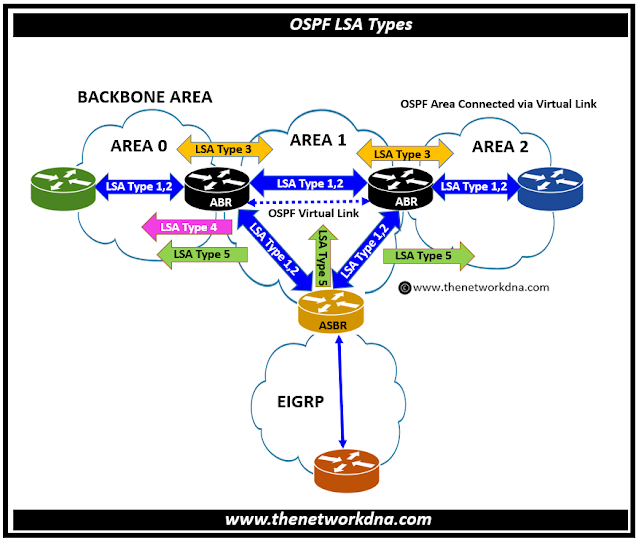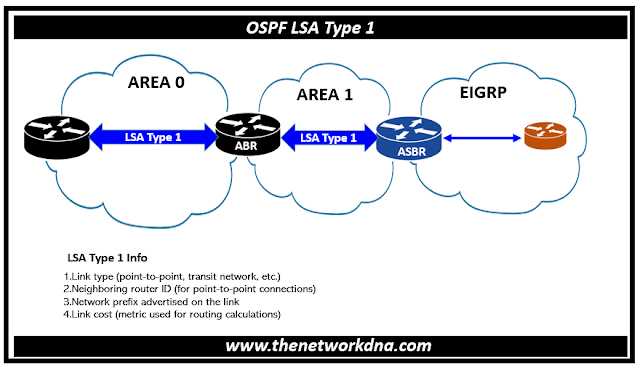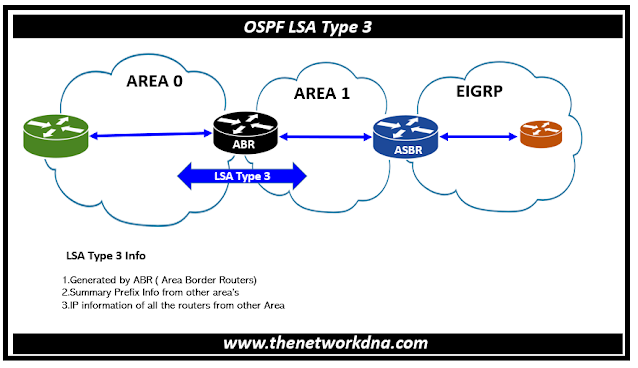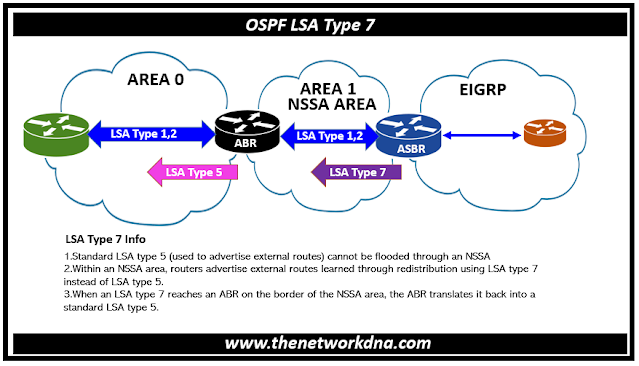Introduction to OSPF LSA Types
Introduction to OSPF LSA Types
OSPF (Open Shortest Path First) is a routing protocol that establishes routing paths within a network. In an OSPF network, regions are used to organize logically related routers. Ideally, all areas should be physically connected to the backbone (Area 0), which serves as a centralized point for routing information.
⭐Related : Top OSPF Protocol Interview Questions and Answers
⭐Related : OSPF protocol : OSPF Packet Types
What is OSPF LSA Types ?
OSPF uses Link-State Advertisements (LSAs) to share information about the network topology with other routers within OSPF network. These LSAs contain details about the state of links, networks, and routes within the OSPF domain.
 |
| Fig 1.1- OSPF LSA Types |
There are various types of LSAs used in OSPF and these are as below
- LSA Type 1 (Router LSA)
- LSA Type 2 (Network LSA)
- LSA Type 3 (Summary LSA)
- LSA Type 4 (Summary ASBR LSA)
- LSA Type 5 (Autonomous System ASBR External LSA)
- LSA Type 7 (NSSA External LSA)
What is OSPF LSA Type 1 (Router LSA) ?
This LSA is generated by each router and defines its directly linked links, including the router ID, link status, and interface IP address. It is limited to the area and does not travel further.
Router ID: Unique identifier for the advertising router.
Link information: Details about each directly connected link, including:
- Link type (point-to-point, transit network, etc.)
- Neighboring router ID (for point-to-point connections)
- Network prefix advertised on the link
- Link cost (metric used for routing calculations)
Routers within an area exchange LSA 1s to provide a full picture of the local network topology. This information is critical for OSPF in determining the shortest pathways for routing traffic.
What is OSPF LSA Type 2 (Network LSA) ?
This LSA is generated by a Designated Router (DR) on a multi-access network segment and contains information on the reachable routers in that segment. Similar to Type 1, it remains within the OSPF area.
The LSA itself contains information about all the routers directly connected to that specific multi-access segments (like Ethernet or Frame Relay). This includes details like router IDs and potentially link information.
What is OSPF LSA Type 3 (Summary LSA) ?
Commonly referred to as Inter-Area LSA, this LSA allows Area Border Routers (ABRs) to broadcast routes from one OSPF area to another. It summarizes network information for the connected area.
LSA type 3 offers a simplified view of the network accessible via the ABR. It usually includes a summary prefix, which indicates a IP addresses information of all the routers inside the other area attached to ABR router
What is OSPF LSA Type 4 (Summary ASBR LSA) ?
This LSA works in partnership with Type 5 to advertise external routes learned from other Autonomous Systems (AS) via an Autonomous System Boundary Router (ASBR).
- Advertise the location (router ID) of the ASBR within the OSPF domain.
- It doesn't advertise the external routes themselves, but rather the location of the ASBR.
- It helps routers within an area understand the context of external routes advertised in LSA type 5.
What is OSPF LSA Type 5 (Autonomous System External LSA) ?
This LSA provides details about external routes that an ASBR router has learnt from other routing protocols, such as BGP, EIGRP or ISIS.
- It enables OSPF to use routing information from external protocols and AS, allowing communication outside the OSPF domain.
- By relying on ASBRs for external route advertisement, it avoids flooding the entire OSPF network with external routing details
- Network administrators can configure redistribution policies on ASBRs to control which external routes are advertised into the OSPF domain.
What is OSPF LSA Type 7 (NSSA External LSA) ?
OSPF LSA type 7, also known as the Not-So-Stubby Area (NSSA) External LSA, serves a specific purpose within a particular OSPF area type: Not-So-Stubby Areas (NSSA).
Standard LSA type 5 (used to advertise external routes) cannot be flooded through an NSSA area since it contradicts the idea of not permitting external routes. Within an NSSA area, routers advertise external routes learned through redistribution using LSA type 7 instead of LSA type 5.
When an LSA type 7 reaches an ABR on the border of the NSSA area, the ABR translates it back into a standard LSA type 5. This LSA type 5 can then be flooded into other OSPF areas where it's understood and used for routing.
⭐Related : OSPF Link LSA and Intra-Area-Prefix : LSA Type 8 and LSA Type 9
Continue Reading...
- OSPF Show Commands on Cisco, Juniper, Huawei, HP and Arista Networks devices
- How to Optimize Your MPLS VPN with OSPF Sham-Link
- OSPF protocol : OSPF Packet Types
- OSPF NSSA Area introduction and Configuration
- Facts about DR and BDR selection in OSPF
- OSPF and BGP configuration setup on a vEdge Router
- OSPF Configuration Guide : OSPF Distance External Command Behavior
- A quick difference: OSPF Vs IS-IS Dynamic Routing Protocol
- Routing: Configuration OSPF To Filter Type-5 LSAs
- Introduction to OSPFv3 AS External LSA Route Calculation
- Differences between OSPFv3 and OSPFv2
- OSPF Over non-Broadcast Networks ( NBMA) basics and Configuration
- OSPF Configurations in Huawei Routers
- Quick tips to OSPF Routing Protocol for Network Engineers
- OSPF Basic configuration Step by step on Cisco Routers
- OSPF Basics : Simple points to study
- OSPF prefix-suppression- Configurations and Verification
- OSPF LSA-ID Conflict : %OSPF-4-CONFLICTING_LSAID
- Cisco IOS-XE: OSPF stuck in INIT - LLS TLV
- Configure Redistribution of iBGP Routes Into OSPF
- Cisco and Juniper Routers : OSPF point to multipoint configurations













